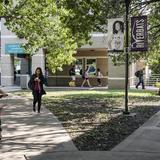- Austin Community College is a nationally recognized college serving Central Texas as the primary gateway to higher education and technical training opportunities. ACC is a two-year community college providing certificates, Associate degrees, Bachelor's degrees, university transfer, workforce training, continuing education, and adult basic education opportunities. The ACC District is a major contributor to the quality of life and economic prosperity of Central Texas.
School Highlights
Austin Community College District serves 34,922 students (40% of students are full-time).
The college's student-teacher ratio of 13:1 is lower than the state community college average of 23:1.
Minority enrollment is 63% of the student body (majority Hispanic), which is less than the state average of 74%.
Quick Facts (2025-26)
- Enrollment: 34,922 students
- In-state tuition: $3,060
- Out-state tuition: $15,624
- Acceptance Rate: 100%
- Student-teacher ratio: 13:1
- Minority enrollment: 63%
- Source: Verified school update
Top Rankings
Austin Community College District ranks among the top 20% of public schools in Texas for:
Category
Attribute
Community Size
School Overview
The teacher population of 2,729 teachers has stayed relatively flat over five years.
Austin Community College District
(TX) Community College Avg.
Carnegie Classification
Baccalaureate/Associate's Colleges: Associate's Dominant
Baccalaureate/Associate's Colleges: Associate's Dominant
Institution Level
At least 2 yrs but < 4 yrs
At least 2 but less than 4 years
Institution Control
Public
Public
Total Faculty
2,729 staff
262 staff
School Calendar
Student Body
The student population of Austin Community College District has declined by 14% over five years.
The student-teacher ratio of 13:1 has decreased from 15:1 over five years.
The Austin Community College District diversity score of 0.68 is less than the state average of 0.70. The school's diversity has stayed relatively flat over five years.
Total Enrollment
34,922 students
4,931 students
Student-Teacher Ratio
13:1
23:1
# Full-Time Students
13,969 students
909 students
# Part-Time Students
20,953 students
4,022 students
# Enrollment Undergraduate
249 students
403 students
# Full-Time Undergraduate Students
34,922 students
890 students
# Full-Time Graduate Students
n/a
40 students
# Part-Time Undergraduate Students
32,117 students
4,166 students
# Part-Time Graduate Students
n/a
47 students
Total Dormitory Capacity
n/a
252 students
% American Indian/Alaskan
1%
n/a
% Asian
6%
6%
% Hispanic
41%
46%
% Black
9%
13%
% White
37%
26%
% Hawaiian
1%
n/a
% Two or more races
2%
3%
% Non Resident races
2%
2%
% Unknown races
1%
4%
Diversity Score
0.68
0.70
College Completion Rate (Students who graduate in less than 4 years)
11%
31%
College Completion Rate (Students who graduate in 4 years or more than 4 years)
15.97%
34%
Average Graduate Earnings (10 Years)
$38,900
$34,600
Tuition and Acceptance Rate
The public in-state tuition of $3,060 is less than the state average of $3,764. The in-state tuition has declined by 71% over four years.
The public out-state tuition of $15,624 is more than the state average of $6,054. The out-state tuition has grown by 19% over four years.
In-State Tuition Fees
$3,060
$3,764
Out-State Tuition Fees
$15,624
$6,054
Tuition Notes
Tuition shown is for Texas residents in ACC taxing district.. Out of district resident annual tuition is 12,996
% Students Receiving Some Financial Aid
68%
84%
Median Debt for Graduates
$10,000
$10,765
Median Debt for Dropouts
$5,500
$5,500
Acceptance Rate
100%
84%
Source: 2024 (or latest year available) Integrated Postsecondary Education Data System (IPEDS) , School Administrators
School Notes
- As one of only 50 community college districts in Texas, Austin Community College provides access to high-quality education at affordable tuition rates. ACC offers university transfer curriculum, technical certificate programs, two-year associate degrees, four-year Bachelor's degrees, foundation skills and English as a Second Language courses, and a highly diverse Continuing Education program. Since the college's founding in 1973, ACC's faculty, staff, and administration have been dedicated to the values that distinguish ACC's unique role in higher education and make the college a critical community resource access to educational opportunities, affordability, quality, diversity, and strong student success services. ACC offers comprehensive academic advising and counseling services, free tutorial services in our Learning Labs, open computer labs, a variety of teaching methodologies, and a host of other support services to help students meet their goals. Austin Community College is accredited by the Commission on Colleges of the Southern Association of Colleges and Schools.
Frequently Asked Questions
How much does Austin Community College District cost?
Austin Community College District's tuition is approximately $3,060 for In-State students and $15,624 for Out-State students.
What is the acceptance rate of Austin Community College District?
The acceptance rate of Austin Community College District is 100%, which is higher than the state average of 84%.
What is Austin Community College District's ranking?
Austin Community College District ranks among the top 20% of community college in Texas for: Largest student body.
In what neighborhood is Austin Community College District located?
Austin Community College District is located in the Highland neighborhood of Austin, TX.
Recent Articles

Community College Success Rates 2025: Outcomes & Trends
Updated 2025 analysis of community college success rates, completion, transfer, costs, enrollment, and strategies that shape student outcomes.

Community Colleges in 2025: Combating Stereotypes with Impact
Updated insights on how community colleges are dispelling myths, growing enrollment, and expanding pathways in 2025.

2025 FAFSA Changes Explained for Community College Students
A comprehensive guide to 2025 FAFSA changes, what community college students must know, new eligibility rules, timelines, and tips to maximize federal aid.























